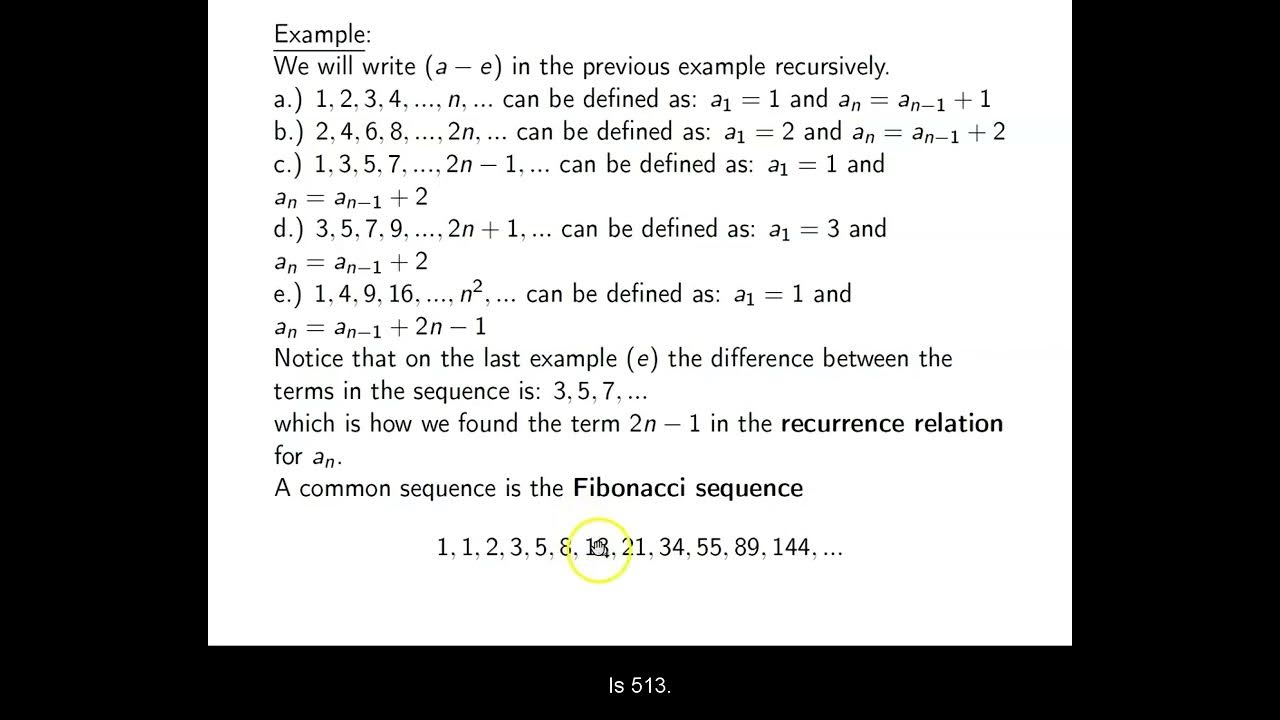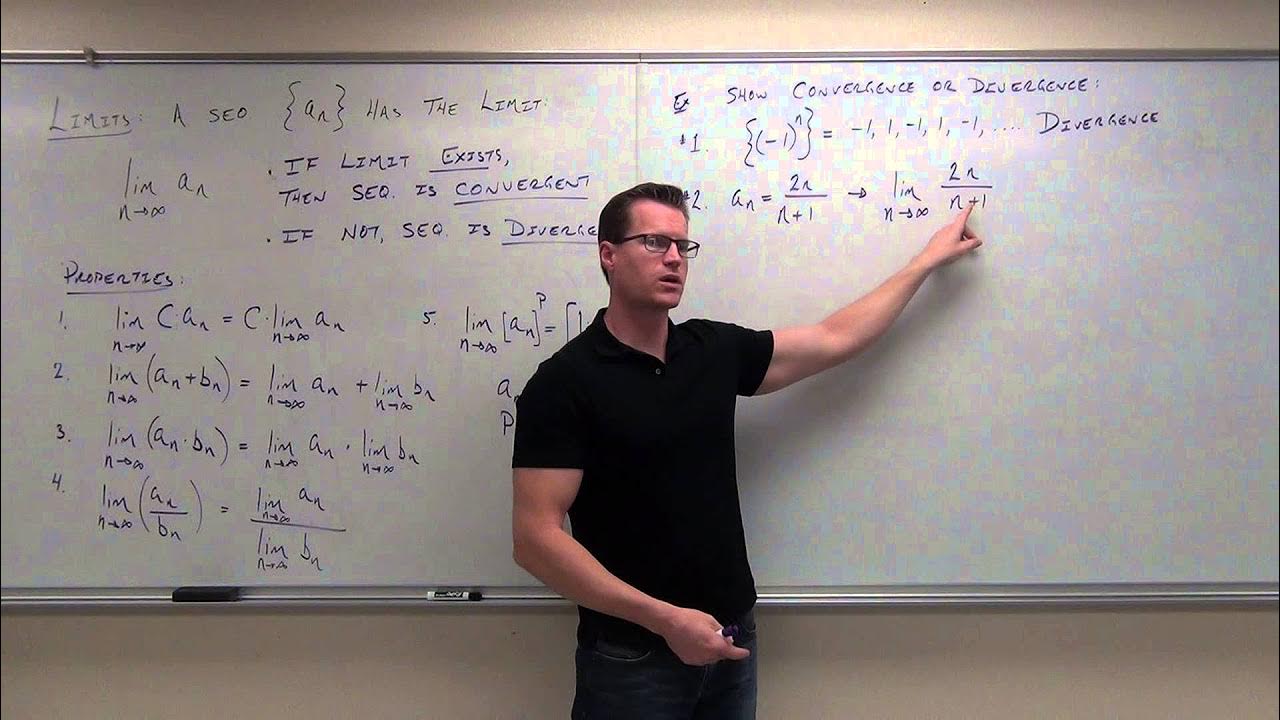Explicit and recursive definitions of sequences | Precalculus | Khan Academy
TLDRThis video script introduces the concept of sequences, both finite and infinite, as ordered lists of numbers. It explains arithmetic sequences, characterized by a constant difference between terms, and demonstrates how to denote and define sequences using explicit functions or recursive definitions. The script illustrates the process with examples, including the notation for sequence terms and the function-like expressions that generate them, emphasizing the foundational role of sequences in mathematics.
Takeaways
- 🔢 A sequence is an ordered list of numbers.
- 🔍 Finite sequences have a limited number of terms, e.g., 1, 4, 7, 10.
- ♾️ Infinite sequences continue indefinitely, e.g., 3, 7, 11, 15, ...
- ➕ Arithmetic sequences are sequences where the same number is added each time.
- 📝 Sequences can be denoted with subscript notation, e.g., a_k for k = 1 to 4.
- 🔠 Each term in a sequence can be represented as a_1, a_2, a_3, etc.
- 📐 Sequences can be defined explicitly using a function of k, e.g., a_k = 1 + 3(k - 1).
- 🧮 The function notation for sequences can also be written as a(k) = 1 + 3(k - 1).
- 🔄 Sequences can also be defined recursively, e.g., a_k = a_(k-1) + 3 with a_1 = 1.
- 🔗 Recursive definitions define each term based on the previous term, providing a base case and a rule for other terms.
Q & A
What is the basic definition of a sequence?
-A sequence is an ordered list of numbers, which can be finite or infinite.
What is the difference between a finite and an infinite sequence?
-A finite sequence has a limited number of terms, while an infinite sequence continues indefinitely.
Can you provide an example of a finite sequence from the script?
-An example of a finite sequence in the script is 1, 4, 7, 10, where each term is obtained by starting at 1 and adding 3 repeatedly.
How is an infinite sequence represented in the script?
-An infinite sequence is represented by starting at a number, such as 3, and then adding a fixed amount, such as 4, repeatedly, with three dots (...) indicating the continuation.
What is an arithmetic sequence?
-An arithmetic sequence is a sequence where the same amount is added to each term to get the next term.
What are the different notations used to denote sequences in the script?
-The script mentions using subscript notation (a_sub_k) and function notation (a(k) or a_k = f(k)) to denote sequences.
How is the first term of a sequence defined in the script?
-The first term of a sequence is defined as a_sub_1 or a(1), depending on the notation used.
What is the function notation used to define the sequence 1, 4, 7, 10 in the script?
-The function notation used is a_k = 1 + (k - 1) * 3, which starts at 1 and adds 3 for each successive term.
How can a sequence be defined using recursive definitions in the script?
-A sequence can be defined recursively by stating the first term and then defining each subsequent term as the previous term plus a constant, such as a_k = a_(k-1) + 3.
What is the difference between explicit and recursive definitions of sequences?
-Explicit definitions provide a direct formula for each term, while recursive definitions start with the first term and express each term as a function of the previous term.
Can every sequence be defined using explicit or recursive functions?
-No, not every sequence can be defined using explicit or recursive functions, but many, including arithmetic sequences, can be.
Outlines
📚 Introduction to Sequences
This paragraph introduces the concept of sequences as ordered lists of numbers, distinguishing between finite and infinite sequences. It provides examples of both, such as a finite sequence starting with 1 and adding 3 repeatedly for four terms, and an infinite sequence starting with 3 and adding 4. The paragraph also explains the terms 'arithmetic sequence' and introduces the notation for sequences, including using subscripts and function notation to define sequences. It clarifies that sequences can be defined explicitly with a formula or recursively, starting with a base case and defining subsequent terms based on the previous one.
🔢 Defining Sequences Explicitly and Recursively
The second paragraph delves deeper into the methods of defining sequences, focusing on explicit and recursive definitions. Explicit definitions involve writing out the sequence or using a formula that calculates each term based on its position. Recursive definitions start with the first term and then define each subsequent term based on the previous one, adding a constant value. The paragraph gives examples of how to define both finite and infinite sequences using these methods, illustrating arithmetic sequences where the same quantity is added repeatedly. It emphasizes that while not all sequences can be defined recursively or explicitly, many, including arithmetic sequences, can be.
Mindmap
Keywords
💡Sequence
💡Finite Sequence
💡Infinite Sequence
💡Arithmetic Sequence
💡Notation
💡Function Notation
💡Recursive Definition
💡Base Case
💡Successive Term
💡Domain
💡Explicit Function
Highlights
Introduction to the concept of sequences as ordered lists of numbers.
Explanation of finite sequences with a defined number of terms.
Illustration of a finite sequence with a simple arithmetic pattern of adding 3.
Introduction of infinite sequences with the example of adding 4 repeatedly.
Use of ellipsis to denote the continuation of an infinite sequence.
Different notations for representing sequences, emphasizing their significance.
Definition of sequences using subscript notation, a_k for k from 1 to 4.
Introduction of function notation as an alternative way to define sequences.
Explanation of how to define a sequence using a function-like expression.
Clarification of the recursive definition of sequences and its application to arithmetic sequences.
Recursive definition of the first sequence starting with a base case and adding 3.
Recursive definition of the infinite sequence starting with 3 and adding 4.
Comparison between explicit and recursive definitions of sequences.
Demonstration of how to verify the correctness of a sequence definition using function notation.
Transition from sequence definition to traditional function notation with domain restrictions.
Exploration of fancier sequences beyond simple arithmetic patterns.
Highlight of the importance of understanding different methods to denote and define sequences.
Final summary emphasizing the flexibility in defining sequences through explicit functions or recursion.
Transcripts
5.0 / 5 (0 votes)
Thanks for rating:





